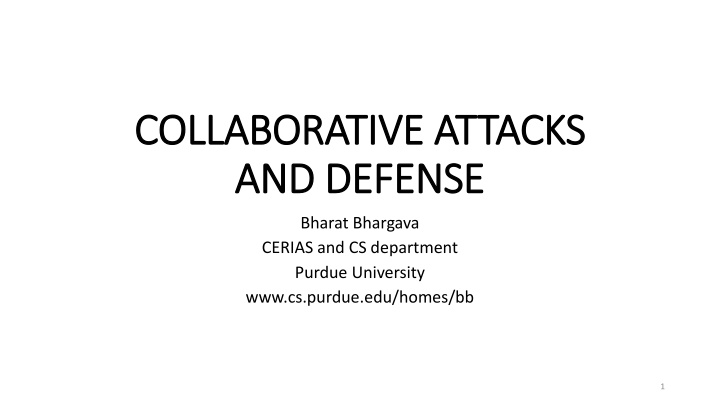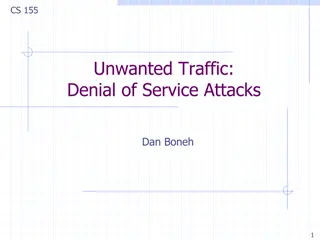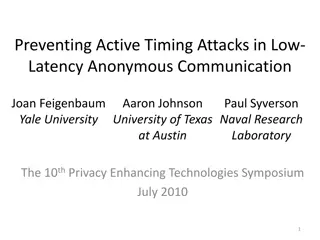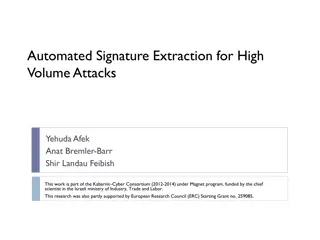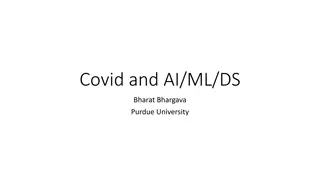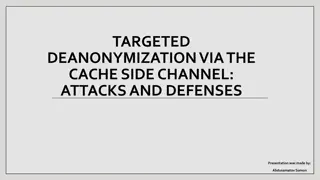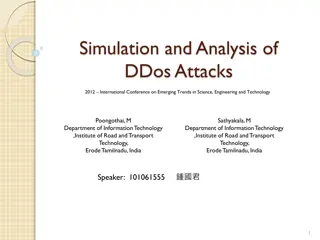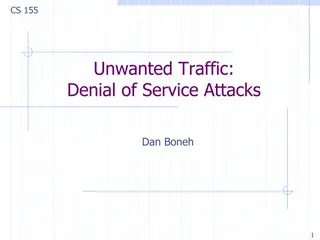Collaborative Attacks and Defense Research at Purdue University
Bharat Bhargava from Purdue University conducts research on collaborative attacks and defense strategies in ad hoc networks. His work involves identifying intruders and exploring ways to protect network integrity. The research motivation includes examining routing protocols, addressing security vulnerabilities, and proposing measures for intrusion prevention and detection.
Download Presentation

Please find below an Image/Link to download the presentation.
The content on the website is provided AS IS for your information and personal use only. It may not be sold, licensed, or shared on other websites without obtaining consent from the author.If you encounter any issues during the download, it is possible that the publisher has removed the file from their server.
You are allowed to download the files provided on this website for personal or commercial use, subject to the condition that they are used lawfully. All files are the property of their respective owners.
The content on the website is provided AS IS for your information and personal use only. It may not be sold, licensed, or shared on other websites without obtaining consent from the author.
E N D
Presentation Transcript
COLLABORATIVE ATTACKS COLLABORATIVE ATTACKS AND DEFENSE AND DEFENSE Bharat Bhargava CERIAS and CS department Purdue University www.cs.purdue.edu/homes/bb 1
Acknowledgement Thanks to all my sponsors in Motorola, Northrup Grumman corporation, Air Force Thanks to my students Thanks to Infosys Cyber security initiative With respect to Bharat Mata whose Matti is my Chandan and all great people of India. 2
Intruder Identification in Ad Hoc Networks Problem Statement Intruder identification in ad hoc networks is the procedure of identifying the user or host that conducts the inappropriate, incorrect, or anomalous activities that threaten the connectivity or reliability of the networks and the authenticity of the data traffic in the networks Some old Papers with fundamentals: On Security Study of Two Distance Vector Routing Protocols for Mobile Ad Hoc Networks , in Proceedings of IEEE International Conference on Pervasive Computing and Communications (PerCom), 2003. On Vulnerability and Protection of Ad Hoc On-demand Distance Vector Protocol , in Proceedings of 10th IEEE International Conference on Telecommunication (ICT),2003. 3
Research Motivation More than ten routing protocols for Ad Hoc networks have been proposed Incl. AODV, DSR, DSDV, TORA, ZRP Research focuses on performance comparison and optimizations such as multicast and multiple path detection Research is needed on the security of Ad Hoc networks. Applications: Battlefields, disaster recovery. 4
Research Motivation Two kinds of attacks target Ad Hoc network External attacks: MAC Layer jam Traffic analysis Internal attacks: Compromised host sending false routing information Fake authentication and authorization Traffic flooding 5
Research Motivation Protection of Ad Hoc networks Intrusion Prevention Traffic encryption Sending data through multiple paths Authentication and authorization Intrusion Detection Anomaly pattern examination Protocol analysis study 6
Research Motivation Deficiency of intrusion prevention increase the overhead during normal operation period of Ad Hoc networks The restriction on power consumption and computation capability prevent the usage of complex encryption algorithms Flat infrastructure increases the difficulty for the key management and distribution Cannot guard against internal attacks 7
Research Motivation Why intrusion detection itself is not enough Detecting intrusion without isolating the malicious host leaves the protection in a passive mode Identifying the source of the attack may accelerate the detection of other attacks 8
Research Motivation Research problem: Intruder Identification Research challenges: How to locate the source of an attack ? How to safely combine the information from multiple hosts and enable individual host to make decision by itself ? How to achieve consistency among the conclusions of a group of hosts ? 9
Related Work Vulnerability model of ad hoc routing protocols [Yang et al., SASN 03] A generic multi layer integrated IDS structure [Zhang and Lee, MobiCom 00] IDS combining with trust [Albert et al., ICEIS 02] Information theoretic measures using entropy [Okazaki et al., SAINT 02] SAODV adopts both hash chain and digital signature to protect routing information [Zapata et al, WiSe 03] Security-aware ad hoc routing [Kravets et al, MobiHOC 01] 10
Related Work in wired Networks Secure routing / intrusion detection in wired networks Routers have more bandwidth and CPU power Steady network topology enables the use of static routing and default routers Large storage and history of operations enable the system to collect enough information to extract traffic patterns Easier to establish trust relation in the hierarchical infrastructure 11
Related Work in wired Networks Attack on RIP (Distance Vector) False distance vector Solution (Bellovin 89) Static routing Listen to specific IP address Default router Cannot apply in Ad Hoc networks 12
Related Work in wired Networks Attack on OSPF (Link State) False connectivity Attack on Sequence Number Attack on lifetime Solution JiNAO:NCSU and MCNC Encryption and digital signature 13
Related Work in Ad Hoc Networks Lee at GaTech summarizes the difficulties in building IDS in Ad Hoc networks and raises questions: what is a good architecture and response system? what are the appropriated audit data sources? what is the good model to separate normal and anomaly patterns? Haas at Cornell lists the 2 challenges in securing Ad Hoc networks: secure routing key management service 14
Related Work in Ad Hoc Networks Agrawal at University of Cincinnati presents the general security schemes for the secure routing in Ad Hoc networks Nikander at Helsinki discusses the authentication, authorization, and accounting in Ad Hoc networks Bhargavan at UIUC presents the method to enhance security by dynamic virtual infrastructure Vaidya at UIUC presents the idea of securing Ad Hoc networks with directional antennas 15
Related Work ongoing projects TIARA: Techniques for Intrusion Resistant Ad-Hoc Routing Algorithm (DARPA) develop general design techniques focus on DoS attack sustain continued network operations Secure Communication for Ad Hoc Networking (NSF) Two main principles: redundancy in networking topology, route discovery and maintenance distribution of trust, quorum for trust 16
Related Work ongoing projects On Robust and Secure Mobile Ad Hoc and Sensor Network (NSF) local route repair performance analysis malicious traffic profile extraction distributed IDs proposed a scalable routing protocol Adaptive Intrusion Detection System (NSF) enable data mining approach proactive intrusion detection establish algorithms for auditing data 17
Evaluation Criteria Accuracy False coverage: Number of normal hosts that are incorrectly marked as suspected. False exclusion: Number of malicious hosts that are not identified as such. Overhead Overhead measures the increases in control packets and computation costs for identifying the attackers (e.g. verifying signed packets, updating blacklists). Workload of identifying the malicious hosts in multiple rounds 18
Evaluation Criteria - cont. Effectiveness Effectiveness: Increase in the performance of ad hoc networks after the malicious hosts are identified and isolated. Metrics include the increase of the packet delivery ratio, the decrease of average delay, or the decrease of normalized protocol overhead (control packets/delivered packets). Robustness Robustness of the algorithm: Its ability to resist different kinds of attacks. 19
Assumptions A1. Every host can be uniquely identified, and its ID cannot be changed throughout the lifetime of the ad hoc network. The ID is used in the identification procedure. A2. A malicious host has total control on the time, the target and the mechanism of an attack. The malicious hosts continue attacking the network. A3. Digital signature and verification keys of the hosts have been distributed to every host. The key distribution in ad hoc networks is a tough problem and deserves further research. Several solutions have been proposed. We assume that the distribution procedure is finished, so that all hosts can examine the genuineness of the signed packets. A4. Every host has a local blacklist to record the hosts it suspects. The host has total control on adding and deleting elements from its list. For the clarity of the remainder of this paper, we call the real attacker as malicious host , while the hosts in blacklists are called suspected hosts . 20
Applying Reverse Labeling Restriction to Protect AODV Introduction to AODV Attacks on AODV and their impacts Detecting False Destination Sequence Attack Reverse Labeling Restriction Protocol Simulation results 21
Introduction to AODV Introduced in 97 by Perkins at NOKIA, Royer at UCSB 12 versions of IETF draft in 4 years, 4 academic implementations, 2 simulations Combines on-demand and distance vector Broadcast Route Query, Unicast Route Reply Quick adaptation to dynamic link condition and scalability to large scale network Support multicast 22
Ideas Monitor the sequence numbers in the route request packets to detect abnormal conditions Apply reverse labeling restriction to identify and isolate attackers Combine local decisions with knowledge from other hosts to achieve consistent conclusions Combine with trust assessment methods to improve robustness 23
Security Considerations for AODV AODV does not specify any special security measures. Route protocols, however, are prime targets for impersonation attacks. If there is danger of such attacks, AODV control messages must be protected by use of authentication techniques, such as those involving generation of unforgeable and cryptographically strong message digests or digital signatures. - http://www.ietf.org/internet-drafts/draft-ietf-manet-aodv-11.txt 24
Message Types in AODV RREQ: route request RREP: route reply RERR: route error 25
Route Discovery in AODV (An Example) D S1 S3 S2 S4 S Route to the source Route to the destination 26
Attacks on routing in mobile ad hoc networks Attacks on routing Active attacks Passive attacks Routing procedure Packet silent discard Routing information hiding Flood network Route request Route broken message False reply Wormhole attacks 27
Attacks on AODV Route request flooding query non-existing host (RREQ will flood throughout the network) False distance vector reply one hop to destination to every request and select a large enough sequence number False destination sequence number select a large number (even beat the reply from the real destination) Wormhole attacks tunnel route request through wormhole and attract the data traffic to the wormhole Coordinated attacks The malicious hosts establish trust to frame other hosts, or conduct attacks alternatively to avoid being identified 28
Impacts of Attacks on AODV We simulate the attacks and measure their impacts on packet delivery ratios and protocol overhead Packet Delivery Ratio 96% Control packet / data packet 0.38 No Attacks Vicious Flooding 91% 2.93 False Distance 75% 0.38 False Destination Sequence Wormhole 53% 0.66 61% 0.41 29
False Destination Sequence Attack Sequence number 5 RREP(D, 4) RREQ(D, 3) D S3 S4 RREQ(D, 3) RREQ(D, 3) S S1 RREQ(D, 3) RREP(D, 20) S2 M Packets from S to D are sinking at M. 30
During Route Rediscovery, False Destination Sequence Number Attack Is Detected, S needs to find D again. Node movement breaks the path from S to M (trigger route rediscovery). (1). S broadcasts a request that carries the old sequence + 1 = 21 (2) D receives the RREQ. Local sequence is 5, but the sequence in RREQ is 21. D detects the false desti- nation sequence number attack. D S3 RREQ(D, 21) S S1 S2 M S4 Propagation of RREQ 31
Reverse Labeling Restriction (RLR) Blacklists are updated after an attack is detected. Basic Ideas Every host maintains a blacklist to record suspicious hosts who gave wrong route related information. The destination host will broadcast an INVALID packet with its signature. The packet carries the host s identification, current sequence, new sequence, and its own blacklist. Every host receiving this packet will examine its route entry to the destination host. The previous host that provides the false route will be added into this host s blacklist. 32
BL {} S3 D INVALID ( D, 5, 21, BL{}, Signature ) BL {} S4 S S1 BL {S2} BL {S1} M S2 BL {} BL {M} S4 BL {} Correct destination sequence number is broadcasted. Blacklist at each host in the path is determined. 33
D1 D2 [M] S3 S4 [M] M D4 [M] D3 [M] S2 S1 M attacks 4 routes (S1-D1, S2-D2, S3-D3, and S4-D4). When the first two false routes are detected, D3 and D4 add M into their blacklists. When later D3 and D4 become victim destinations, they will broadcast their blacklists, and every host will get two votes that M is malicious host. Malicious site is in blacklists of multiple destination hosts. 34
Combine Local Decisions with Knowledge from Other Hosts When a host is destination of a route and is victim by any malicious host, it will broadcast its blacklist. Each host obtains blacklists from victim hosts. If M is in multiple blacklists, M is classified as a malicious host based on certain threshold. Intruder is identified. Trust values can be assigned to other hosts based on past information. 35
Acceleration in Intruder Identification D3 D2 D1 M2 M3 M1 S2 S1 S3 Coordinated attacks by M1, M2, and M3 Multiple attackers trigger more blacklists to be broadcasted by D1, D2, D3. 36
Reverse Labeling Restriction (RLR) Update Blacklist by Broadcasted Packets from Destinations under Attack Next hop on the false route will be put into local blacklist, and a counter increases. The time duration that the host stays in blacklist increases exponentially to the counter value. When timer expires, the suspicious host will be released from the blacklist and routing information from it will be accepted. 37
Deal With Hosts in Blacklist Packets from hosts in blacklist Route request: If the request is from suspicious hosts, ignore it. Route reply: If the previous hop is suspicious and the query destination is not the previous hop, the reply will be ignored. Route error: Will be processed as usual. RERR will activate re-discovery, which will help to detect attacks on destination sequence. Broadcast of INVALID packet: If the sender is suspicious, the packet will be processed but the blacklist will be ignored. 38
Attacks of Malicious Hosts on RLR Attack 1: Malicious host M sends false INVALID packet Because the INVALID packets are signed, it cannot send the packets in other hosts name If M sends INVALID in its own name If the reported sequence number is greater than the real sequence number, every host ignores this attack If the reported sequence number is less than the real sequence number, RLR will converge at the malicious host. M is included in blacklist of more hosts. M accelerated the intruder identification directing towards M. 39
Attack 2: Malicious host M frames other innocent hosts by sending false blacklist If the malicious host has been identified, the blacklist will be ignored If the malicious host has not been identified, this operation can only make the threshold lower. If the threshold is selected properly, it will not impact the identification results. Combining trust can further limit the impact of this attack. 40
Attack 3: Malicious host M only sends false destination sequence about some special host The special host will detect the attack and send INVALID packets. Other hosts can establish new routes to the destination by receiving the INVALID packets. 41
Experimental Studies of RLR The experiments are conducted using ns2. Various network scenarios are formed by varying the number of independent attackers, number of connections, and host mobility. The examined parameters include: Packet delivery ratio Identification accuracy: false positive and false negative ratio Communication and computation overhead 42
Simulation Parameter Simulation duration 1000 seconds Simulation area 1000 * 1000 m Number of mobile hosts 30 Transmission range 250 m Pause time between the host reaches current target and moves to next target Maximum speed 0 60 seconds 5 m/s Number of CBR connection 25/50 Packet rate 2 pkt / sec 43
Experiment 1: Measure the Changes in Packet Delivery Ratio Purpose: investigate the impacts of host mobility, number of attackers, and number of connections on the performance improvement brought by RLR Input parameters: host pause time, number of independent attackers, number of connections Output parameters: packet delivery ratio Observation: When only one attacker exists in the network, RLR brings a 30% increase in the packet delivery ratio. When multiple attacker exist in the system, the delivery ratio will not recover before all attackers are identified. 44
Increase in Packet Delivery Ratio: Single Attacker X-axis is host pause time, which evaluates the mobility of host. Y-axis is delivery ratio. 25 connections and 50 connections are considered. RLR brings a 30% increase in delivery ratio. 100% delivery is difficult to achieve due to network partition, route discovery delay and buffer. 45
Increase in Packet Delivery Ratio: Multiple Attackers X-axis is number of attackers. Y-axis is delivery ratio. 25 connections and 50 connections are considered. RLR brings a 20% to 30% increase in delivery ratio. 46
Experiment 2: Measure the Accuracy of Intruder Identification Purpose: investigate the impacts of host mobility, number of attackers ,and connection scenarios on the detection accuracy of RLR Input parameters: number of independent attackers, number of connections, host pause time Output parameters: false positive alarm ratio, false negative alarm ratio Observation: The increase in connections may improve the detection accuracy of RLR. When multiple attackers exist in the network, RLR has a high false positive ratio. 47
Accuracy of RLR: Single Attacker 30 hosts, 25 connections 30 hosts, 50 connections Host Pause time (sec) # of normal hosts identify the attacker # of normal hosts marked as malicious # of normal hosts identify the attacker # of normal hosts marked as malicious 0 24 0.22 29 2.2 10 25 0 29 1.4 20 24 0 25 1.1 30 28 0 29 1.1 40 24 0 29 0.6 50 24 0.07 29 1.1 60 24 0.07 24 1.0 The accuracy of RLR when there is only one attacker in the system 48
Accuracy of RLR: Multiple Attackers 30 hosts, 25 connections 30 hosts, 50 connections # of attackers # of normal hosts identify all attackers # of normal hosts marked as malicious # of normal hosts identify all attackers # of normal hosts marked as malicious 1 28 0 29 1.1 2 28 0.65 28 2.6 3 25 1 27 1.4 4 21 0.62 25 2.2 5 15 0.67 19 4.1 The accuracy of RLR when there are multiple attackers 49
Experiment 3: Measure the Communication Overhead Purpose: investigate the impacts of host mobility and connection scenarios on the overhead of RLR Input parameters: number of connections, host pause time Output parameters: control packet overhead Observation: When no false destination sequence attacks exist in the network, RLR introduces small packet overhead into the system. 50
